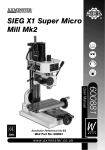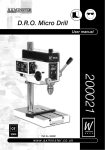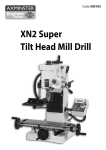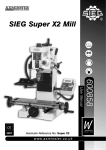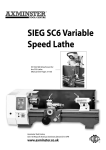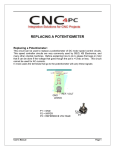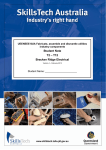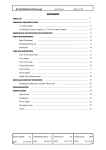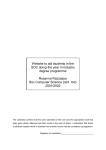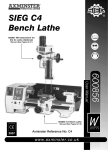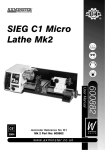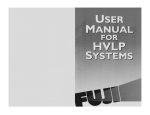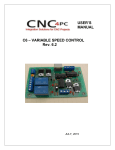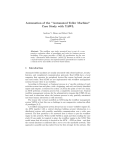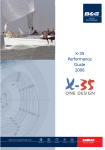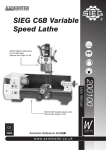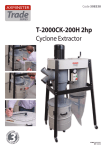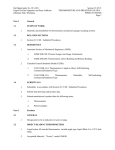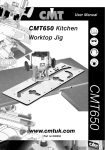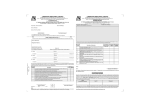Download User Manual - Axminster Power Tool Centre
Transcript
Code 505098 SX1 Super Micro-Mill MKII Index of Contents Page No Index of Contents 02 Declaration of Conformity What’s in the Included General Instructions for 230V Machines Initial Assembly and Testing Specification Definitions Parts Identification and Description Machine Illustration of the Micro-Mill General Operating Instructions Settings and adjustments Maintenance Illustrated Parts Breakdown Illustrated Parts List Micro-Mill Accessories Micro-Mill Oiling Points 02 03 04 05-06 07 07 08-10-12 09-11-13-14 15 16 17 18-19 20-21 22 23 Declaration of Conformity The undersigned, Ole Stilling authorised by Shanghai SIEG Machinery Co., Ltd. No.555 Caofeng Rd., South to No. 17 Bridge of Caoan Rd., Shanghai declares that this product: (Micro Mill) SX1 manufactured by Shanghai SIEG Machinery Co. is in compliance with the following standards or standardisation documents EN55014-1:2000, EN55014-2:1997 EN61000-3-2:2000, EN61000-3-3:1995 in accordance with Council Directives (89/336/EEC amended by 93/68/EEC) symbols below advise that you follow the correct Warning The safety procedures when using this machine. Fully read manual and safety instructions before use 02 Ear protection should be worn Eye protection should be worn HAZARD Motor gets hot What’s in the Included Quantity Item 1 No. Micro Mill with Chuck and Draw Bar fitted Box containing:1 No. 3 No. 1 No. 1 No. 1 No. 1 No. 1 No. 4 No. 1 No. 1 No. 1 No. 1 No. Model Number SX1 Chuck Key Rod Handles (detached for packing) Double Open Ended Spanner 5mm A/F x 5.7mm A/F Double Open Ended Spanner 8mm A/F x 10mm A/F Nipple ‘C’ Spanner 28mm-32mm Allen Key 3mm Allen Key 6mm ‘T’ Slot Keepers Tommy Bar Oiling Bottle Spare Fuse (250v x 1 Amp) User Manual ! Please read the Instruction Manual prior to using your new machine; as well as the installation procedure, there are daily and periodic maintenance recommendations to help you keep your machine on top line and prolong its life. Keep this Instruction Manual readily accessible for any others who may also be required to use the machine. Having unpacked you machine and its accessories, please check the contents against the equipment list "What’s included", if there are any discrepancies, please contact Axminster Tool Centre using the procedures laid down in the catalogue. Please dispose of the packaging responsibly, much of the material is bio-degradable. The machine and its accessories will arrive coated with heavy corrosion preventative grease. This will need to be cleaned from the machine, its components and accessories prior to it being set up and commissioned. Use coal oil, paraffin or a proprietary degreaser to remove the barrier grease. Be warned, it will stain if you splash it on clothing etc., wear overalls, coverall et al., rubber gloves are also a good idea, as is eye protection if your cleaning process tends to be a little bit enthusiastic. After cleaning, lightly coat the exposed metal surfaces of the machine with a thin layer of light machine oil. N.B If you used paraffin/kerosene make sure you apply this thin film sooner rather than later. 03 General Instructions for 230V Machines Good Working Practices/Safety The following suggestions will enable you to observe good working practices, keep yourself safe and maintain your tools and equipment in good working order. ! WARNING!! KEEP TOOLS AND EQUIPMENT OUT OF THE REACH OF YOUNG CHILDREN Mains Powered Tools Primary Precautions These machines are supplied with a moulded 13 Amp. plug and 3 core power cable. Before using the machine inspect the cable and the plug to make sure that neither are damaged. If any damage is visible have the damaged item inspected/repaired by a suitably qualified person. If it is necessary to replace the plug, it is preferable to use an ‘unbreakable’ type that will resist damage on site. Only use a 13 Amp plug, and make sure the cable clamp is tightened securely. Fuse as required. If extension leads are to be used, carry out the same safety checks on them, and ensure that they are correctly rated to safely supply the current that is required for your machine. Work Place/Environment The machine is not designed for sub-aqua operation, do not use when or where it is liable to get wet. If the machine is to be used outside and it starts to rain (unusual though this would be in U.K.), stop work and move it inside. If machine has got wet; dry it off as soon as possible, with a cloth or paper towel. Do not use 230Va.c. powered machines anywhere within a site area that is flooded or puddled, and do not trail extension cables across wet areas. Keep the machine clean; it will enable you to more easily see any damage that may have occurred. Clean the machine with a damp soapy cloth if needs be, do not use any solvents or cleaners, as these may cause damage to any plastic parts or to the electrical components. Keep the work area as uncluttered as is practical, this includes personnel as well as material. ! (Under no circumstances should CHILDREN be allowed in work areas) It is good practice to leave the machine unplugged until work is about to commence, also make sure to unplug the machine when it is not in use, or unattended. Always disconnect by pulling on the plug body and not the cable. Once you are ready to commence work, remove any tools used in the setting operations (if any) and place safely out of the way. Re- connect the machine. Carry out a final check e.g. check the cutting tool, drill bit, saw blade etc., is securely tightened in the machine, check you have the correct speed and function set, check that the power cable will not ‘snag’ etc. Make sure you are comfortable before you start work, balanced, not reaching etc. If the work you are carrying out is liable to generate flying grit, dust or chips, wear the appropriate safety clothing, goggles, gloves, masks etc., If the work operation appears to be excessively noisy, wear ear-defenders. If you wear your hair in a long style, wearing a cap, safety helmet, hairnet, even a sweatband, will minimise the possibility of your hair being caught up in the rotating parts of the machine, likewise, consideration should be given to the removal of rings and wristwatches, if these are liable to be a ‘snag’ hazard. Consideration should also be given to non-slip footwear, etc. Do not work with cutting or boring tools of any description if you are tired, your attention is wandering or you are being subjected to distraction. A deep cut, a lost fingertip or worse; is not worth it! Do not use this machine within the designated safety areas of flammable liquid stores or in areas where there may be volatile gases. There are very expensive, very specialised machines for working in these areas, THIS IS NOT ONE OF THEM. Check that cutters, drills, blades etc., are the correct type and size, are undamaged and are kept clean and sharp, this will maintain their operating performance and lessen the loading on the machine. Above all, OBSERVE…. make sure you know what is happening around you, and USE YOUR COMMON SENSE. 04 Initial Assembly and Testing Ideally, your mill should be installed close to a correctly rated power supply, in a warm dry environment, well ventilated and illuminated by bright clear natural light, with adequate access all around the machine, and sufficient adjacent storage space for your tools, accessories and material. The Micro-Mill is best mounted on a rigid bed; this is to ensure stability of the machine and to attenuate any vibration that is generated when the machine is running. The bed should be flat and set level in both planes, and at a height that enables comfortable operation of the machine. It is not necessary to anchor the bed through to the floor, but it must be stable enough to remain immovable during any normal forceful operations (especially tightening) carried out whilst operating your mill. If you are preparing your own bed for the machine, it should be at least 400mm long by 250mm wide; (to cover the footprint of the base (354 x 216), you will need to drill 4 No. 8.5mm holes to allow for bolt fixing. Set out the centres of the holes in the following matrix: 294mm x 186mm Bolt the mill to the bed using M8 nuts, bolts and washers. Locate and identify the 3 rod handles from the packing box. Fit these to the 3 wheel handles, (Work table control, traverse feed control, head raise and lower control.) ! Please read the section entitled Identification and Parts description so that you may more easily identify the parts to which reference is made in the text. Testing When the lathe is mounted to your satisfaction, proceed as follows:a) Close the chuck jaws b) Check the millhead is ‘locked’ in position on the column. c) Check that all loose items are removed from the worktable. d) Set the worktable approximately mid-positioned under the chuck jaws. e) Check the speed control is switched OFF (fully anti-clockwise). f) Check the Forward/Off/Reverse Switch is in the Off position g) Select L (Low) on the gear box . h) Connect the machine to the mains supply and switch power on. i) Turn the Speed Control Switch On (Clicks On) and Select Forward on the Forward/Off/Reverse switch. J) Check the Amber LED (Fault Light) is illuminated and the green light is illuminated. k) Switch the Speed Control Switch Off ( Clicks Off) and the Amber Led is now Off and the Green light stays on. 05 Initial Assembly and Testing l) Turn the Forward/Off/Reverse switch to Off position (Clicks Off) all lights are now off. m) Select Forward on the Forward/Off/Reverse switch. n) Turn the Speed Control Switch On and advance until the Chuck starts to rotate. o) Turn the Forward/Off/Reverse switch to Off position, check that the machine stops, turn the Forward/Off/Reverse switch to Forward, check that the Green light comes on and the Amber LED comes on and the machine does not start. Turn all switches off ( All lights are off). p)Turn Forward/Off/Reverse switch to Forward. q) Turn the Speed Control Switch On (Clicks On), advance until the chuck starts to rotate. r) Over a period of approximately 5 minutes advance the speed in stages to maximum, run at maximum for at least 2 minutes, check that there is nothing untoward, (no excessive vibration, speed progression is smooth etc.). Stop the spindle and change the gear selector to H (High), carry out the previous check. Repeat the checks with the motor set in reverse. s) If all the above checks are correct, stop the spindle, (turn the speed control to zero and select Off on the direction selector switch. Ensure the fine feed control is disengaged, using the ‘coarse’ feed lever handle, exercise the quill up and down, check the movement is smooth and precise. t) Select the fine feed function, (if necessary ‘joggle’ the feed hand to enable the gears to mesh). Raise and lower the quill using the fine feed control. Check the movement is smooth and precise, there are no hard spots and the feed doesn’t bind up. u) Exercise the worktable and the traverse feed, check you have full travel and that the movements are smooth and ‘tight’. Reposition the worktable approximately mid-way and lock in position, check that the table will not move when ‘reasonable’ force is applied to either the traverse or longitudinal feed handles. (Note. Reasonable force is meant to indicate that force you would apply to proceed with the next action, and that the resistance to the action would make you investigate as to why the action was blocked. It is not meant as a challenge for you to bunch muscles and heave). v) Ensure the head lock clamp is loosened and exercise the rise and fall, driving the head up and down the tool post. Check the movement is smooth and tight. Leave the head fairly well down the tool post for the next check. w) Loosen the tilt clamp bolts, and tilt the tool post to the left and right, clamp the tool post in an arbitrary position and tighten the clamp bolts. Check that the tool post remains locked in place. (WARNING. If the tool post is tilted too far out of the vertical the mill can become unstable if it is not fastened to a solid workbench. Exercise care.) Return the tool post to the vertical. x) If all the above checks are correct, your mill is now ready for use. Enjoy. 06 Specification Code 505098 Model SIEG SX1 Power 150W Spindle Speed Variable 100-1,000 & 100-2,000rpm Spindle Taper 2MT Nose of Spindle to Table (MAX) Head Tilt 45˚ 0˚ 45˚R Longitudinal Table Movement Lateral Table Movement Table Size Overall L x W x H Weight 255mm 180mm 90mm 240 x 145mm 430 x 355 x 715mm 32kg Definitions ‘X’ Axis. This is the axis described by the work table as it is moved side to side. Normally, movement that moves the tool to the right in the workpiece is referred to as +ve ‘X’, and movement that moves the tool to the left in the workpiece is referred to as –ve ‘X’. Where the initial position of the tooling and the worktable is designated 0,0. (Horizontal plane only). ‘Y’ Axis. This is the axis described by the work table as it is moved from front to back.(Traverse) Normally movement that moves the tool to the front in the workpiece is referred to as-ve ‘Y’, and movement that moves the tool to the rear in the workpiece is referred to as+ve ‘Y’. Where the initial position of the tooling and the worktable is designated 0,0.(Horizontal plane only). ‘Z’ Axis This is the axis described by the worktable in the vertical plane. (Not possible with this machine). However, to establish a point in space, the co-ordinates can be transferred to the ‘tip’ of the tooling, whereby, if we assume that the tool and the worktable in their initial positions, where designated 0,0,0, (Horizontal and vertical planes) any point above the tool tip is referred to as +ve ‘Z’, and any point below the tool tip is referred to as -ve ‘Z’ 07 Parts Identification and Description Please take some time to identify the various parts of your machine so that you are familiar with the terminology we will use to enable you to set up and operate your Mill safely and correctly. Base casting This is the ‘Stand’ for the milling m/c. It is a square casting with a seating flange to the rear, which mounts the Tilt Housing for the Main Tool Post. There are 4 No. 8.75mm holes in the approximate corners of the base to enable it to be bolted to a bench or the stand. There is also a dovetail slide machined on the front top surface of the base, to mount the traverse slide of the worktable. Main tool post This is the column of the mill, it is an 65 x 50 bar with a dovetail slide machined on the front onto which the milling head is mounted, the lower part is the circular ‘boss’ for the tilt assembly. On the left side of the post a scale, graduated in mm’s, is mounted to read against an adjustable pointer mounted on the head casting. Rise and fall drive screw The Rise and Fall drive screw is anchored in a machined housing at the top of the main tool post. It has a wheel and rod handle keyed to the shaft to enable the screw to be turned. It is fed through a threaded dog that is bolted to the head casting allowing the head to be moved up and down. Viewed from above the drive screw is turned clockwise to raise the head and anti-clockwise to lower it. Tilt housing The tilt housing is mounted to the base casting using 4 bolts. The tilt ‘boss’ of the main tool post is mated to the housing and clamped by a further 4 bolts. The main tool post can tilt 45(degrees) from the vertical either left or right. There is an adjustable pointer and a scale mounted on the housing to give an indication of the amount of tilt that has been applied. Traverse slide The traverse slide casting mounts onto the dovetail slide of the base casting. There is a gybe strip fitted to the right side dovetail to maintain the fit. In the front face of the slide is a machined housing which mounts and anchors the drive shaft for the traverse feed. Under the slide (on the base) is a threaded dog mounted in a fixed position, through which the traverse drive shaft is threaded so as to enable the slide to be driven back and forth. The top of the traverse slide has a female dovetail machined into it, perpendicular to the lower dovetail. This marries with the dovetail on the underside of the worktable. The front face of the dovetail is fitted with a gybe strip to maintain the fit. The top of the slide also has a fixed threaded dog mounted to it, through which the drive shaft of the worktable is threaded to allow the worktable to be driven from side to side. In between the grubscrews and locknuts of the gybe strip adjustors is an M4 caphead bolt that can be driven forward to clamp the gybe strips against the dovetails to enable the traverse and longitudinal movements to be locked in position. Traverse slide control The traverse slide is driven using the wheel and rod handle at the front of the machine. Behind the boss of the handle is a graduated ring (thimble) so that the movement of the slide can be measured. The thimble is held to the drive shaft by friction, and can be pre-positioned to a predetermined start or stop dimension. 08 Machine Illustration of the Micro-Mill Fig 1 Main tool post Worktable Traverse slide Rise & fall drive screw Worktable control Base casting Traverse drive control Worktable gybe strip adjustors Tilt scale Typ. 4 bolts Fig 2 Tilt housing 0-45˚ tilt Rear View 09 Parts Identification and Description Worktable The Worktable is a machined casting 240mm long by 145mm wide. There is a dovetail section machined in the underside to mate with the traverse slide. There are 3 x 8mm open ended ‘T’ slots machined in the table along its length, to facilitate the fixing of machine vices or clamps. The worktable is mounted onto the traverse slide. The right end face of the worktable has a housing machined in it to mount and anchor the drive shaft assembly. Worktable drive control The Worktable slide is driven using the wheel and rod handle at the end of the table. Behind the boss of the handle is a graduated ring (thimble) so that the movement of the worktable can be measured. The thimble is held to the drive shaft by friction, and can be pre-positioned to establish a predetermined start or stop dimension. Milling head This is the ‘milling machine’ and the descriptions of its various parts and components are detailed as follows:- Milling head casting The main casting to which all the components are attached. The head has a dovetail housing machined at the rear, which allows the casting to be fitted to the Main Tool Post. The left side of the dovetail slide is fitted with a gybe strip to maintain the fit. Head clamp and scale Similar to the traverse and longitudinal slides, centrally located between the gybe strip adjusters and locknuts is an M4 bristol handled bolt that clamps the gybe strip against the slide to effect a locking action for the rise and fall of the head. In the same location is an adjustable pointer which reads against the scale mounted on the main tool post, to enable the head to be moved against a reference point. Rise and fall An ‘L’ shaped casting that is threaded to accept the rise and fall drive screw, drive screw dog and is driven along the thread when the screw is turned. As it is bolted to the milling head, the head will therefore follow its movement as it is being driven. Motor and gearbox The motor and gearbox assembly are mounted above the main head casting at the top of the arbor sleeve. The motor drive is geared through to the spindle with an intermediate 2:1 gearbox. Gear change knob The gear change knob allows the selection of the high or low ratio of the gear train. The speed of the spindle is then governed by the speed control on the motor panel. (You may have to ‘joggle’ the chuck/tool to aid the meshing action). Motor A 220V d.c. motor rated at 150W. Feed Handle Lever handle that is used to drive the quill (and hence the chuck or the tool) up and down. The boss of the handle is fitted to the end of a ‘splined’ gear shaft. This ‘splined’ gear is, in turn, engaged in the rack cut into the quill body. There is a counter balance spring in the arbor and sleeve assembly, giving a more controlled ‘feel’ during drilling operations. It also retracts the quill when drilling is completed. 10 Machine Illustration of the Micro-Mill Fig 3 Motor Milling head casting Gearbox Rise & Fall drive screw dog Fine feed control Coarse feed scale Thimble Chuck Feed handle Low ratio High ratio Gear change knob Scale Pointer Normal Fine feed Fig 4 Head clamp Head clamp and scale assembly Fine feed engage knob Fine feed thimble 11 Parts Identification and Description Fine feed assembly The fine feed assembly floats around the splined gear shaft that drives the quill up and down. When the action of the fine feed mechanism is required; pulling out ‘engage’ knob of the fine feed control meshes the gearing (you may have to ‘joggle’ the feed handle to aid the meshing action) between the splined shaft and the fine feed control shaft; this enables the spindle to be driven by the fine feed control wheel with greater precision. Behind the boss of the fine feed control wheel handle is a graduated ring (thimble) so that the movement of the quill can be measured. The thimble is held to the drive shaft by friction, and can be pre-positioned to establish a predetermined start or stop dimension. Motor control panel Power On LED Green LED that indicates that power is available to the motor. i.e. mains is applied, fuse is intact and the Emergency stop switch is not activated. Fault LED (marked UNNORMAL) Amber LED that indicates that there is a fault or an incorrect control sequence. i.e. the chuck guard interlock has been activated or the speed control is activated without forward or reverse direction being selected. The Motor will not run if the fault LED is illuminated. If the safety interlock is activated, the safety interlock will remain in force until the interlock is reset and the start sequence re-initiated. Fuse Cap Access cap for the 20mm fuse cartridge (1 Amp 250V) Speed Control Knob Round raised ridge knob connected to the circuit that controls the spindle speed (100-1000 rpm or 100-2000 depending upon the gearbox selection). Forward /Off/Reverse Switch Three position switch that controls the direction of rotation of the spindle. Forward indicates that the spindle is turning clockwise (looking down from above, reverse, the spindle is turning anticlockwise. The centre OFF position inhibits the spindle from turning in either direction, under motor drive. Quill hold pocket The size of the machine precludes any ‘fancy’ locking mechanism for the quill. There is a blind pocket on the spindle that accepts the tommy bar supplied in the tool kit, to enable the spindle to be held in position whilst the draw bar is loosened. Draw bar cover A moulded plastic cover that clips into the top of the Motor Gearbox assembly, to afford protection from the rotating top of the draw bar, when the quill is at the top of its travel. Draw bar (unseen) This is a metal rod, threaded M10 at one end and with an 8mm squared shank and flange machined on the other. It is fitted through the spindle mandrel to hold the fitted tool/tooling hard into the No2 MT taper of the spindle shaft. 12 Machine Illustration of the Micro-Mill Fig 5 Motor control panel Fuse cap Power on LED Fault LED Forward /Off/Reverse switch Speed control knob 13 Machine Illustration of the Micro-Mill Fig 6 Blind pocket Fig 7 Draw bar cover 14 Spindle Top of draw bar General Operating Instructions ! Warning Do not operate the mill in any function unless the head clamping lever is tightened. Tool Changing Note. The taper socket in the spindle mandrel does not have a ‘drive flat’ and all tooling, including the drill chuck is secured and driven by the taper lock and the draw bar. Make sure the power is switched off or better still remove the power from the machine. Locate and put to hand the 8mm A/F spanner and the tommy bar. Remove the Draw Bar Cover. Hold the quill immoveable by inserting the tommy bar into the quill hold pocket and loosen the draw bar. Unscrew two or three turns and then strike sharply with a hammer (preferably a copper face, to prevent the head of the draw bar peining over) this will break the lock between the tool and the spindle tapers . Unscrew the draw bar from the tool. Ensure the tool is supported, i.e. will not fall onto the workpiece/table et al. When it is free put the tool carefully aside, remove the draw bar, check the thread, check the taper and the thread of the new tool are clean and undamaged, introduce the new tool into the taper, re-insert the draw bar and screw into the top of the tool. Screw in the draw bar finger tight. Hold the quill immoveable and tighten with the spanner. DO NOT OVERTIGHTEN. Replace the draw bar cover. Remove all tooling and reconnect the machine. Ensure the tool path is clear, switch on, and check that the tool is correctly seated, is running true etc. If all is O.K, proceed. General Safety Points Milling (all cases) Ensure the workpiece is securely clamped to the table. Along the longitudinal Axis (X) Ensure that the quill is locked in position before milling is commenced. Ensure the traverse slide lock is tightened. Along the Traverse Axis (Y) Ensure that the quill is locked in position before milling is commenced. Ensure the worktable lock is tightened. Milling or Drilling Vertically (Z) Ensure the traverse slide and the worktable locks are tightened. 15 Settings and adjustments Feed scales The three thimbles that are mounted on the feed shafts of the worktable, the traverse feed and the fine feed control should move freely with the motion of the handles and not slip. The thimbles can be turned, using more force, independently of the handle in order to set a predetermined start or finish point. If the thimbles are ‘slipping’ i.e. not maintaining their place relative to the handle, whilst the handle is turning; the cause is almost inevitably dirt, swarf et al., between the pressure plate and the thimble. To rectify this, undo the nut and washer securing the handle to the shaft, remove the hand wheel, and then remove the keyed collar and thimble assembly. Take care that the key does not drop out of the shaft. Gradually separate the thimble from the keyed collar, by twisting and turning, until there is sufficient space to clean the mating surfaces. ! Warning The friction drive between the collar and the thimble is effected by a wire spring (like part of a circlip) that is housed in a groove in the collar and rubs against the inside bore of the thimble. If the collar and the thimble are separated too far, the groove and the spring are exposed. The spring can fall out and if not lost, it is awkward to re-compress the spring so that the thimble will slide completely back onto the collar. Once the mating surfaces are clean, mate the key and the keyway and fit the collar/thimble assembly to the shaft. Refit the washer and the securing nut, and tighten. Tighten until the handwheel, thimble and collar assembly are too tight to move. Undo the securing nut a quarter turn and check that the drive handle rotates freely and there is not excessive backward and forward play in the shaft. (The handle etc, forms one side of the drive screw anchor into the slide). Check the thimble remains synchronized with the handle whilst it is being turned. Your Micro-Mill has been factory set and adjusted, however, during its life time you may find occasion whereby the mill needs adjusting to maintain its accuracy and optimum performance. These adjustments can be made as follows:Worktable and Traverse feed adjustment The worktable and the traverse feed are both mounted over dovetail sections. In order to maintain the ‘tightness’ of the fit; between the sloping surface of the component and its mating surface a gybe strip has been inserted. (At the front of the worktable, and to the right hand side of the traverse feed). To adjust the gybe strips, use supplied allen key and spanner, release the lock nuts and screw the gybe strip grubscrews clockwise to compensate for any slackness or anti-clockwise to loosen the movement. Check, using the feed handles, that worktable and the traverse feed moves smoothly, If not, repeat the adjustments until the movement is smooth and tight over the whole of the travel. Milling Head adjustment The Milling Head is mounted over a dovetail section. In order to maintain the ‘tightness’ of the fit; between the sloping surface of the component and its mating surface, on the left hand side, a gybe strip has been inserted. To adjust the gybe strip, use the supplied allen key and spanner, release the lock nuts and screw the gybe strip grubscrews clockwise to compensate for any slackness or anti-clockwise to loosen the movement. Check, using the rise and fall drive feed handles, that the head moves smoothly, If not, repeat the adjustments until the movement is smooth and tight over the whole of the travel. 16 Maintenance Your Mill is a precision tool. In order to maintain this precision and prolong its useful life, it is advised that you follow the recommended daily and periodic maintenance tables printed below. Daily and Periodic Maintenance Daily Carry out a visual inspection. Repair any damage immediately. Minor damage to the beds should be taken out with an oilstone. Move the worktable and the traverse feed back and forth by hand, check that the movement is smooth. Spread a light film of oil over the worktable and the traverse slide bed. Oil the end bearings of the drive shafts. Squirt oil onto the slide faces of mating components. Exercise the components to ensure the oil is spread over both visible and obscure surfaces. Daily after-use 1. Clean all swarf and chips away from the machine bed, slide surfaces, and the tool post. 2. Exercise the slides and ensure no swarf etc., is lodged in the drive shaft tunnels. If you have been using a coolant make sure the machine is thoroughly dried off. 3. Check the tool, ensure it is usable the next time, if not re-sharpen or replace the tool tip. 4. Lightly oil spray all the machine beds and surfaces. 5. Clean and lightly oil any tools you may have been using (drill chucks, spanners, chuck keys etc), and put them away. 6. Switch off the power supply. Disconnect the plug. 7. Cover the machine over with a dust cloth. Weekly 1. Move the traverse slide fully back to give access to the tunnel, blow out to make sure all swarf is cleared away and heavily spray oil the tunnel, exercise the slide to work the oil into the drive thread and to lubricate the dog. 2. Spray oil the slide and the worktable bed, exercise the worktable to spread the oil to all surfaces, both hidden and visible. 3. Spray oil the underside of the machine onto the drive screws, exercise to ensure the oil is coating all components. 4. Clean and spray oil the rise and fall drive screw, exercise to ensure all parts are coated. 5. Check the movement of the worktable, the traverse slide and the head, check they are smooth and ‘tight’, if necessary reset the gybe strips until the movements are smooth and tight. 6. Wipe the quill outer sleeve clean and lightly oil, exercise the quill to spread the oil in the sleeve bushes. Monthly a) Give the motor a good ‘blow through’ to remove any dust, dirt etc, b) Check all the interlocks function correctly. Accessories There are numerous accessories for the machine listed in the Axminster catalogue. Some are illustrated at the rear of this manual. 17 Illustrated Parts Breakdown 18 Illustrated Parts Breakdown 19 Illustrated Parts List 20 Illustrated Parts LIst PC Board Replacement Part No: Part No: 600883 21 Micro-Mill Accessories Vice 55mm Code: (100034) 2MT 6mm collet Code: (100023) 2MT 10mm collet Code: (100024) Quick vice 50mm Code: (100022) Clamping kit Code: (100033) 22 Micro Mill Oiling Points Top of draw bar cover removed for clarity OIL Oil 23 Please dispose of packaging for the product in a responsible manner. It is suitable for recycling. Help to protect the environment, take the packaging to the local recycling centre and place into the appropriate recycling bin. Only for EU countries Do not dispose of electric tools together with household waste material. In observance of European Directive 2002/96/EC on waste electrical and electronic equipment and its implementation in accordance with national law, electric tools that have reached the end of their life must be collected separately and returned to an environmentally compatible recycling facility. Axminster Tool Centre, Unit 10 Weycroft Avenue, Axminster, Devon EX13 5PH axminster.co.uk
























